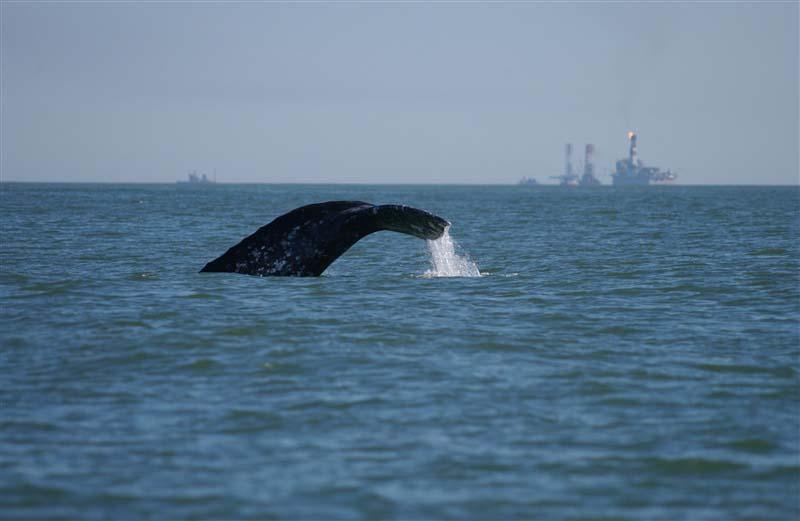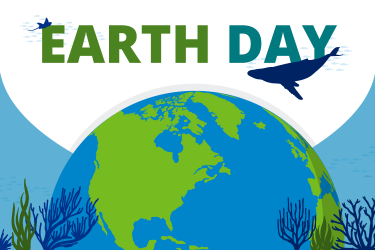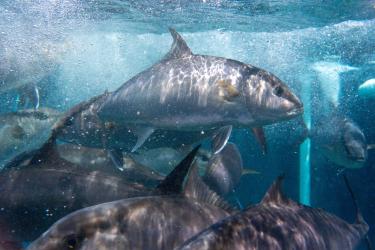Listening to detect sounds and communicating with sound is crucial to a whale’s survival. However, oceans are far from quiet places! Human-caused ocean noise is rising. NOAA uses its Ocean Noise Strategy to protect whales and other marine species and their habitats. It guides the development of data tools, projects, and partner collaborations to better understand and reduce the threat of human-produced noise.
Sound is Critical to a Whale’s Wellbeing
A whale’s world is full of sound. Marine mammals, including whales, use underwater sound as their primary way to communicate and assess their environment. Sound is critical for communication, and important for navigation, finding food, and avoiding predators. A whale’s soundscape contains a multitude of melodies. They range from vocalizations from members of its own species to the harmonies of its neighbors, like fish, crustaceans, seals, and dolphins. It also includes the percussion of other natural sources like wind, rain, ice, and underwater earthquakes. But since the beginning of the industrial age, humans have also added to the orchestra of the underwater soundscape.
Human Noise Influences Global Soundscapes
The ocean soundscape includes many sounds generated from human activities that are important to our economy and national security. Ocean noises include sounds produced for specific purposes, such as active military or research sonar and seismic air guns from geophysical surveys to find oil and gas products. Human-made noise also includes unintentional sounds from activities like vessels and construction activities (e.g., pile driving associated with coastal construction or wind farms). These human activities and the sounds they generate have been on the rise.
As the amount of ocean noise grows, so does the concern over the potential impacts on marine species and habitats. For whales, exposure to these noises can cause immediate effects such as behavioral disruption and impacts on hearing. They can also result in longer term effects, such as the masking of critical sounds or increased stress.
For example, large baleen whales, such as gray whales or humpback whales, may change their migratory path to avoid exposure to loud noises such as seismic airgun surveys or industrial noise. Deep-diving toothed whales, such as beaked whales, may alter their dive and feeding behavior in the presence of active sonar or other sonar-like sounds, such as those used for military training and testing. Often, what animals are doing at the time of exposure or their previous experience with noises can determine how they respond to the noise. Resting individuals, mom-calf pairs, or individuals exposed to a new noise source may be more easily disturbed.
Also, increases in background noise can make it more difficult for whales to communicate, navigate, and hear critical sounds from predators and prey. This is called “masking.” These effects are especially notable in areas of persistent and heavy human use, such as commercial shipping lanes and busy ports. NOAA scientists use computer models to quantify the loss in “listening space” or “communication space.” This helps us understand how whale communication may be limited in different areas and circumstances due to the impact from ocean noises.
All of these impacts, if experienced repeatedly over longer durations or together with other types of stressors, can affect the health, reproductive success, and survival of whales and other species.
NOAA’s Role in Understanding and Managing Underwater Noise
NOAA is the lead U.S. federal agency responsible for understanding and working to reduce the threat of human-produced noise on whales and all other protected marine species and their habitats. We have developed the Ocean Noise Strategy to articulate our agency’s vision, and guide science and management actions for addressing ocean noise. Our strategy promotes outreach and engagement with stakeholders and international partners to further our vision. It emphasizes the creation of management decision support tools.
For example, via the Marine Mammal Protection Act and Endangered Species Act, NOAA Fisheries aim to reduce short and long-term noise impacts through required mitigation, such as:
-
Turning off/powering down a sound source when animals get within a certain distance (shut-down)
-
Preventing sound exposure within a critical area or time, such as a known feeding or calving area (time/area closure)
Monitoring designed to learn more about the impacts of the activity on whales and other protected species may also be required. Further, NOAA Fisheries develops tools and guidance to better understand and quantify impacts from underwater noises.
NOAA scientists can also use underwater microphones, called hydrophones, to conduct passive acoustic monitoring and listen to what is happening below the surface. PAM is an extremely useful and powerful tool to understand trends in where and how whales live over space and time. For example, our Northeast Fisheries Science Center developed a Passive Acoustic Cetacean Map tool showing when and where specific whales and dolphins have been heard in the North Atlantic Ocean since 2004.
NOAA has also implemented long-term listening capabilities, such as the NOAA/National Park Service Ocean Noise Reference Station Network and SanctSound. These projects measure both biological and human-made sounds across ecosystems. The data from these efforts help to better understand large-scale changes in the marine environment from pressures such as climate change. They serve to guide critical management decisions, such as activity planning and mitigation development.
Since underwater sounds and whales extend across national borders, we work with international partners to address noise produced from commercial shipping, which is the main source of continuous underwater sound in the ocean. Via the International Maritime Organization, NOAA, along with numerous U.S. federal agencies and other nations, developed guidelines to reduce shipping noise impacts marine life. NOAA continues to work on this important topic across the globe, including the Arctic.
Our journey in understanding the complexity of ocean soundscapes is just beginning. However, we cannot underestimate our role and influence on these precious ecosystems. Understanding and minimizing underwater noise takes both science and management. We all need to listen, learn, and partner with the global community to reduce our noisy impact on the amazing soundscapes and symphonies produced by whales and the ocean’s other inhabitants.







